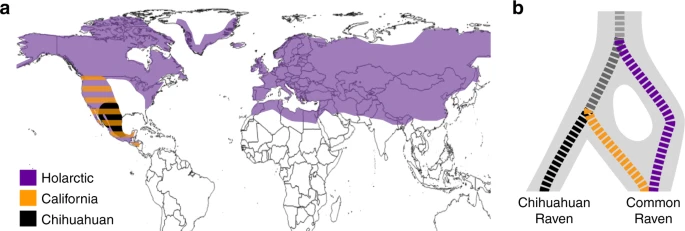In this article, the species of the holoarctic(common) raven, the Californian raven and the Chihuahuan raven were hypothesized to have been more separated in genotype in the past. Scientists have studied the ravens' mitochondrial DNA, one of the nuclear introns on the Z chromosome, several autosomal introns and genome-wide SNPs and mapped out how much was shared between the species. Combined with the ecological niches of the current day ravens and behaviors, a comparison of the shared genetic material was made between all of the birds.
For the mitochondrial DNA, it showed that the holoarctic and the Californian ravens shared mtDNA but only what is currently in the northwestern US. But the Z nuclear intron did shed a light on the paraphyletic branches of the holoarctic and the Californian ravens. The Chihuahuan raven split off earlier to speciate. Taking over a period of a million years, the ravens were once their own species with the holoarctic and the Californian lines converging into a single lineage, and from tens of thousands of years and hybridized.
This also would shed light on how humans came to be. Since speciation reversal is still evident in the Homo sapiens genotype. With bits of Neanderthal and Denosovian DNA in our genotype, there could have been hybridization between differing homind groups and that the parts were swapped over eons of randomized mating.

No comments:
Post a Comment